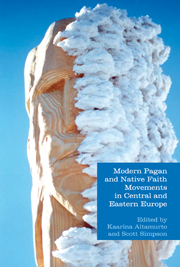Book contents
- Frontmatter
- Contents
- Contributors
- 1 Introduction: Modern Pagan and Native Faith Movements in Central and Eastern Europe
- Part I Overviews
- Part I Country Studies
- 6 Contemporary Paganism in Lithuanian Context: Principal Beliefs and Practices of Romuva
- 7 The Dievturi Movement in Latvia as Invention of Tradition
- 8 Polish Rodzimowierstwo: Strategies for (Re)constructing a Movement
- 9 Ukrainian Paganism and Syncretism: “This Is Indeed Ours!”
- 10 Russian Rodnoverie: Six Portraits of a Movement
- 11 Czech Neopagan Movements and Leaders
- 12 Neopaganism in Slovenia
- 13 Bulgarian Society and the Diversity of Pagan and Neopagan Themes
- 14 Romanian Ethno-Paganism: Discourses of Nationalistic Religion in Virtual Space
- 15 Neopaganism in Hungary: Under the Spell of Roots
- 16 Neopaganism in the Mari El Republic
- 17 A Neopagan Movement in Armenia: The Children of Ara
- Part III Thematic Studies
- Bibliography
- Index
13 - Bulgarian Society and the Diversity of Pagan and Neopagan Themes
from Part I - Country Studies
- Frontmatter
- Contents
- Contributors
- 1 Introduction: Modern Pagan and Native Faith Movements in Central and Eastern Europe
- Part I Overviews
- Part I Country Studies
- 6 Contemporary Paganism in Lithuanian Context: Principal Beliefs and Practices of Romuva
- 7 The Dievturi Movement in Latvia as Invention of Tradition
- 8 Polish Rodzimowierstwo: Strategies for (Re)constructing a Movement
- 9 Ukrainian Paganism and Syncretism: “This Is Indeed Ours!”
- 10 Russian Rodnoverie: Six Portraits of a Movement
- 11 Czech Neopagan Movements and Leaders
- 12 Neopaganism in Slovenia
- 13 Bulgarian Society and the Diversity of Pagan and Neopagan Themes
- 14 Romanian Ethno-Paganism: Discourses of Nationalistic Religion in Virtual Space
- 15 Neopaganism in Hungary: Under the Spell of Roots
- 16 Neopaganism in the Mari El Republic
- 17 A Neopagan Movement in Armenia: The Children of Ara
- Part III Thematic Studies
- Bibliography
- Index
Summary
CONTEXT OF THE PROPAGATION OF PAGANISM IN BULGARIAN SOCIETY
“Pagan” (broadly understood) beliefs, habits, and practice characterize not only the activities of organized religious communities and institutions, but they also penetrate into broader spheres of social communication, everyday consciousness, and culture. This means that paganism is an important object of research which touches a great number of essential characteristics of social interaction, and influences a range of functional indicators of the social system.
In this text, I define “paganism” as a combination of local customs, rituals, belief in deities, personifying the elements, or local idols; and practices based on those views, including witchcraft, sorcery, forms of extra-sensory perceptions, and experiences of transcendent realities. In turn, “Neopaganism” is defined as modern religious and gnostic movements, created on the basis of reconstructions of ancient pagan religions and combined with elements from world religions.
The presence of pagan belief and practice in contemporary Bulgarian society demonstrates how traditional social structures continue in a postmodern context. The persistence of pagan views and practices in turn limit other institutional and cultural dynamics tied to official religious institutions, such as the Bulgarian Orthodox Church. The weaving of magical ideas and concepts into everyday religious practice subverts existing social order through alternative motivations that do not coincide with publicly legitimized values.
- Type
- Chapter
- Information
- Publisher: Acumen PublishingPrint publication year: 2013

